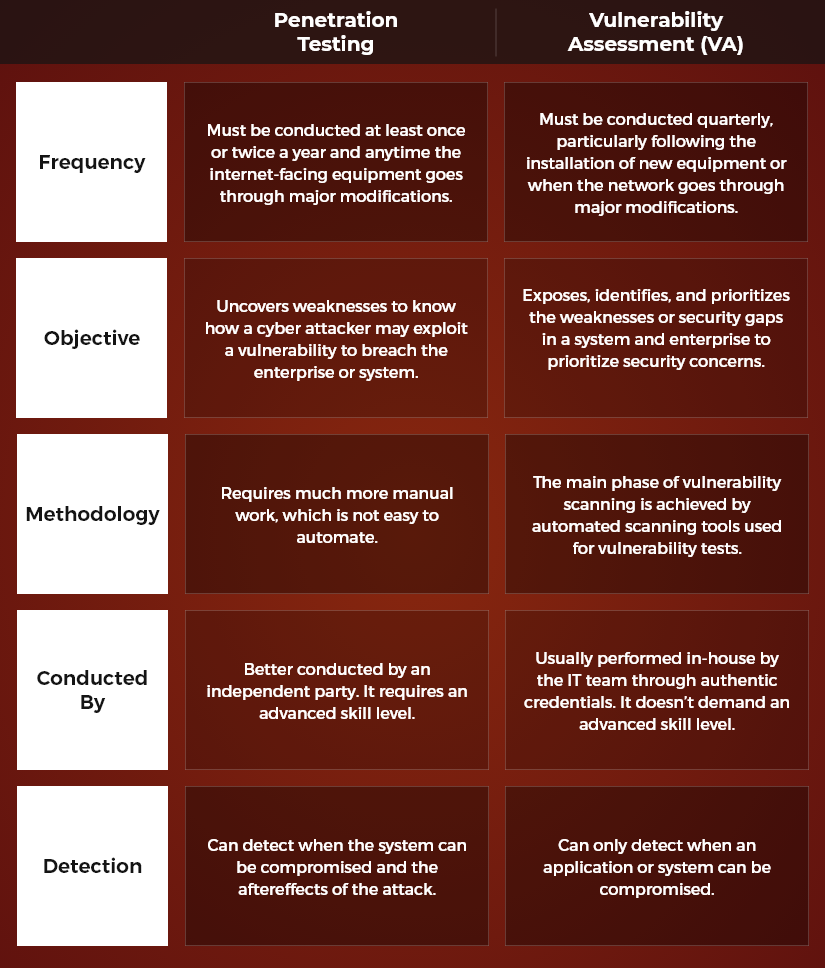September 22, 2021

Vulnerability Assessment (or scanning) and Penetration Testing are often believed to be similar procedures. But there are some key differences between both, and it majorly depends on how you test your systems to detect vulnerabilities.
In simple terms, Vulnerability Assessment is an automated, high level test that is used to search potential vulnerabilities. A Penetration Test is a simulated, manual, cyber-attack against your computer system to check for exploitable vulnerabilities. Both are important in their own ways but as a business owner or a senior management member in your company, you should know how they differ and what their importance is.
In this article we will analyze these key differences.
What is Penetration Testing?
Penetration testing is an in depth, hands-on examination of existing systemic weaknesses and flaws. A quality penetration testing or pentest assesses a target to identify weaknesses or security flaws, that a threat actor can exploit. These exploitable weaknesses include unpatched software, poor vulnerability management procedures, security gaps, ineffectual security settings on systems, etc.
Penetration Tests are extremely thorough and provide a detailed approach for dealing with a specific issue. Through this test, you can easily find and remediate vulnerabilities in software applications and networks.
What is a Vulnerability Assessment?
A vulnerability assessment or vulnerability scanning, is an automated process for detecting, measuring, and prioritizing the vulnerabilities in each system and the entire environment. Vulnerability scans are conducted using automated scanners such as those manufactured by Rapid7, Nessus, Qualys, Retina, and GFI LANGuard.
You are liable to the PCI DSS (Payment Card Industry Data Security Standard) if your company handles cardholder data. This means that you are expected to perform vulnerability scans every quarter and follow any significant modifications to the network. Likewise, quarterly external scans differ from quarterly internal scans.
Their objectives are different
The execution of a penetration test depends on several situations like compliance regulations, application launches, protection from breach or leak, and/or any significant updates in network or application. Similarly, based on the different reasons for performing a pentest, its objectives can also differ significantly. Pentest reports are thorough and allows the senior management members (or anyone in similar role) to prioritize the risks on basis of budget or threat level.
The objectives of a vulnerability assessment vary slightly from a penetration test. Vulnerability scans are cyclical in nature. Scans are performed when new vulnerabilities are released, network and application change, after a breach or leak, or as part of a continuous process within a good vulnerability management program. Vulnerability Scans are affordable but there are more false positives due to the process constantly identifying a threat that’s not real.

Penetration Testing and Vulnerability Assessment are important tools against cybercriminals. The reports will help you determine controls that are best suited for the business and department. But apart from these tools, you should also make sure that your employees go through regular training sessions. Penetration testing training on these topics will keep your security team as well as other departments aware about best practices, trends and new threats. And nothing comes close to EC-Council’s CPENT Program.
CPENT: The Only Certification Your Employees Will Ever Need
EC-Council’s Certified Penetration Tester (CPENT) program is a fully online, remotely proctored practical exam that challenges you through a grueling 24-hour performance-based, hands-on exam. If your Cybersecurity Teams have only been working in flat networks, CPENT’s live practice range will take their skills to the next level.
The heart of the CPENT program is all about helping your employees master their Penetration Testing skills by putting them to use on EC-Council’s live cyber ranges. The CPENT ranges were designed to be dynamic in order to give your employees a real-world training program, so just as targets and technology continue to change in live networks, both the CPENT practice and exam ranges will mimic this reality as our team of engineers continue to add targets and defenses throughout the CPENT course’s lifetime.
20000+ penetration testing jobs remain vacant worldwide!
Get your Penetration Testing Certification and grow in your career!
FAQs
The post What’s the Difference Between Penetration Testing and Vulnerability Assessment? appeared first on EC-Council Official Blog.
Article posted by: https://www.eccouncil.org/
——————————————————————————————————————–
Infocerts, 5B 306 Riverside Greens, Panvel, Raigad 410206 Maharashtra, India
Contact us – https://www.infocerts.com
This is the article generated by feed coming from KaliLinux.in and Infocerts is only displaying the content.
